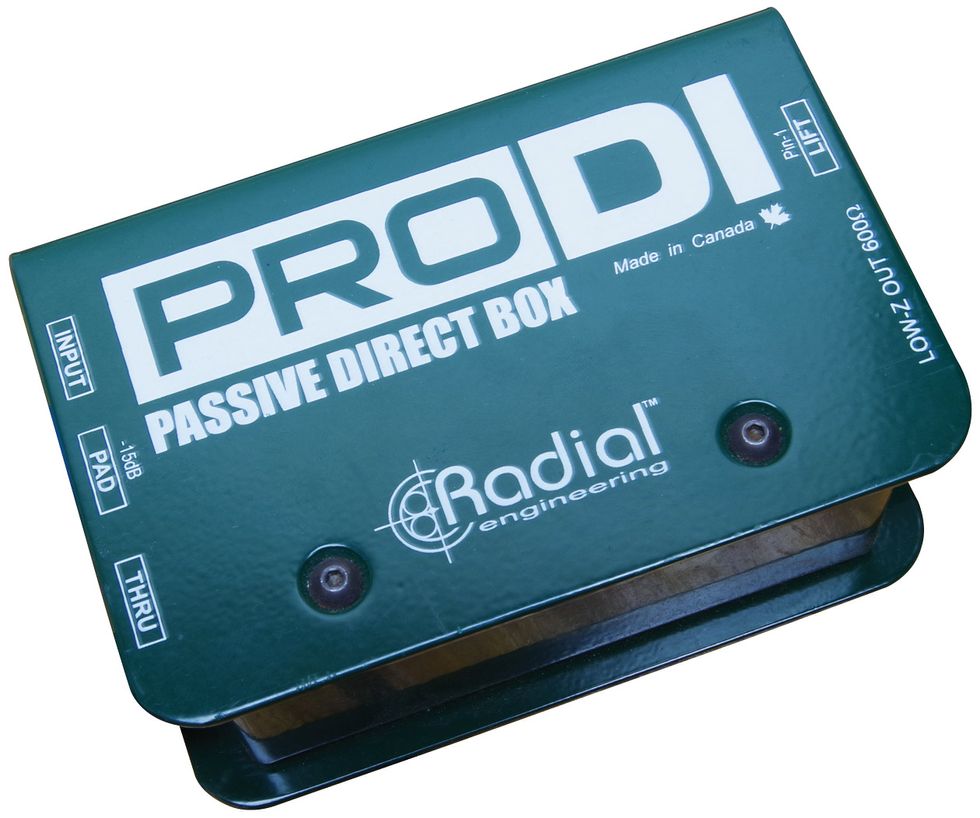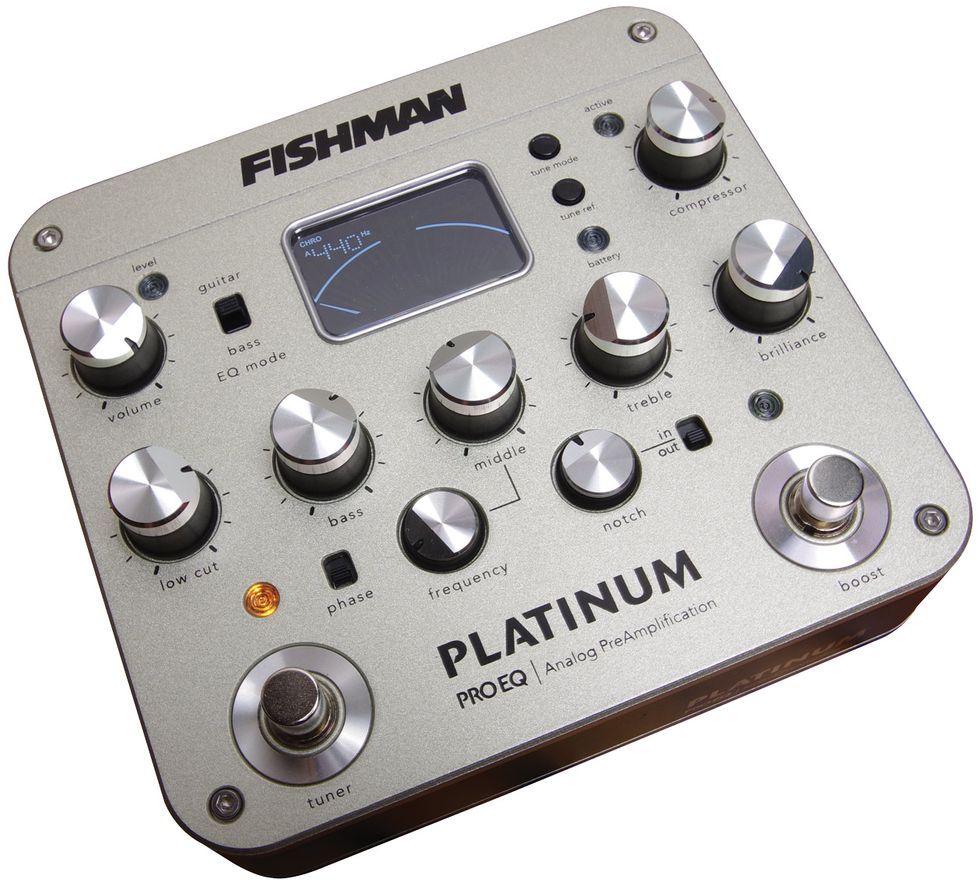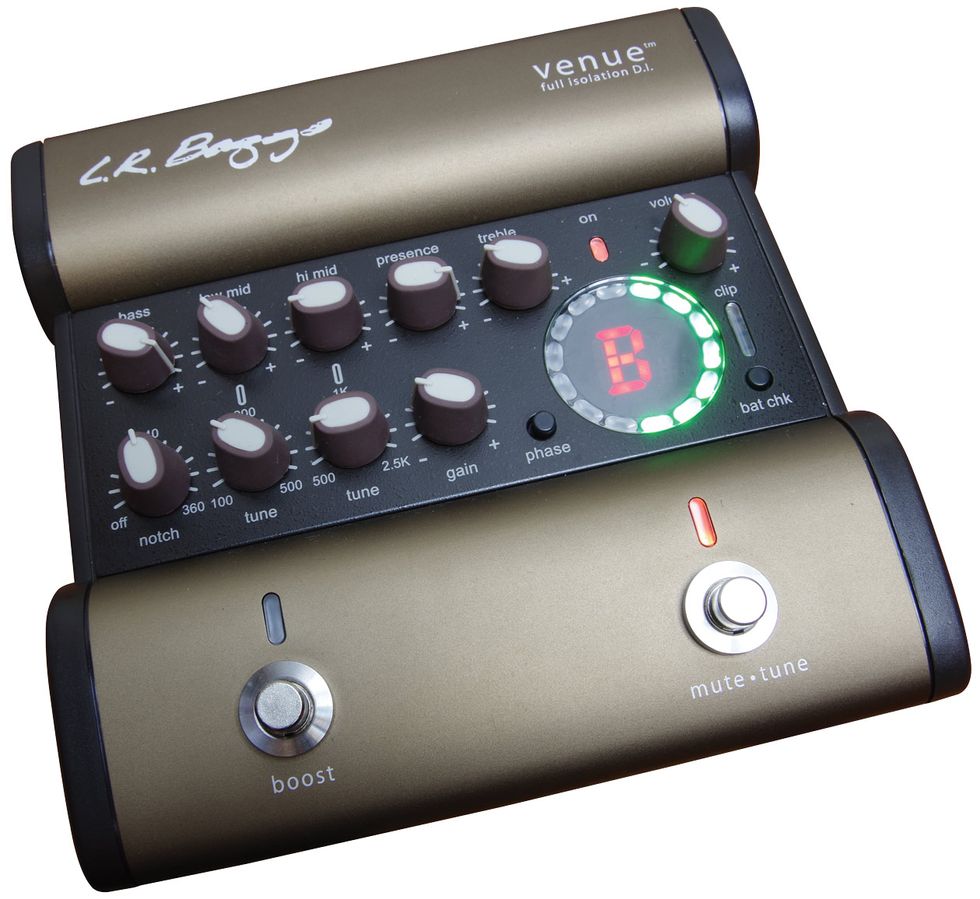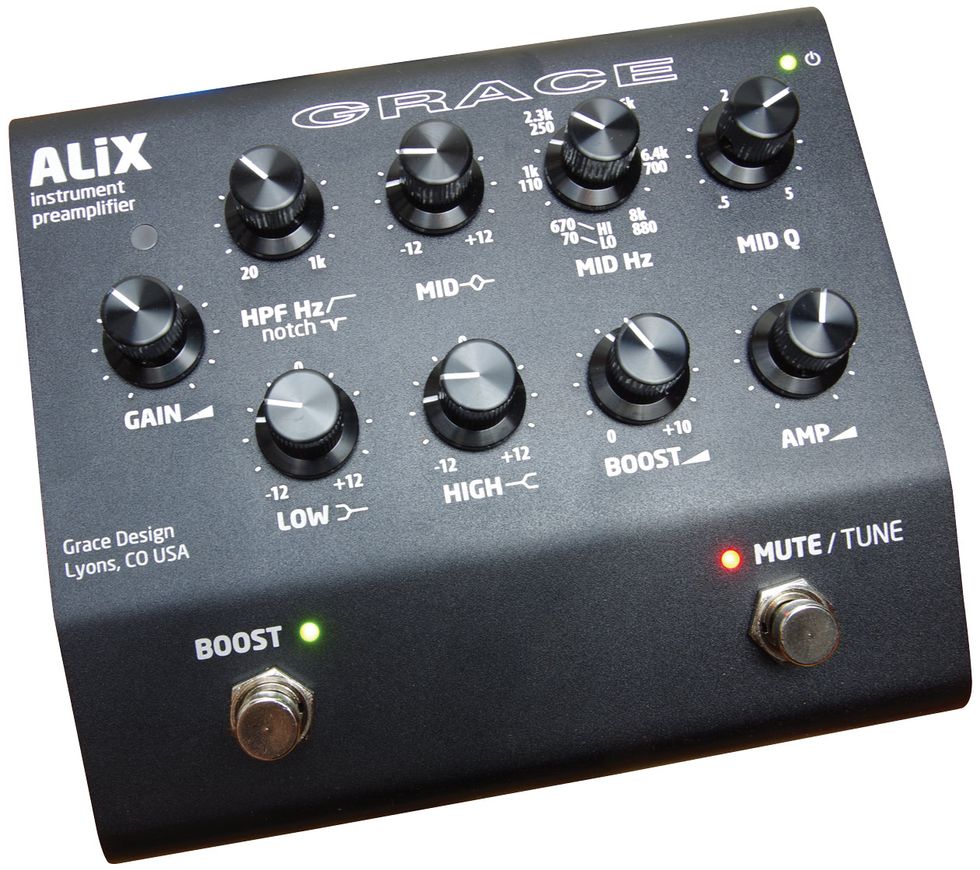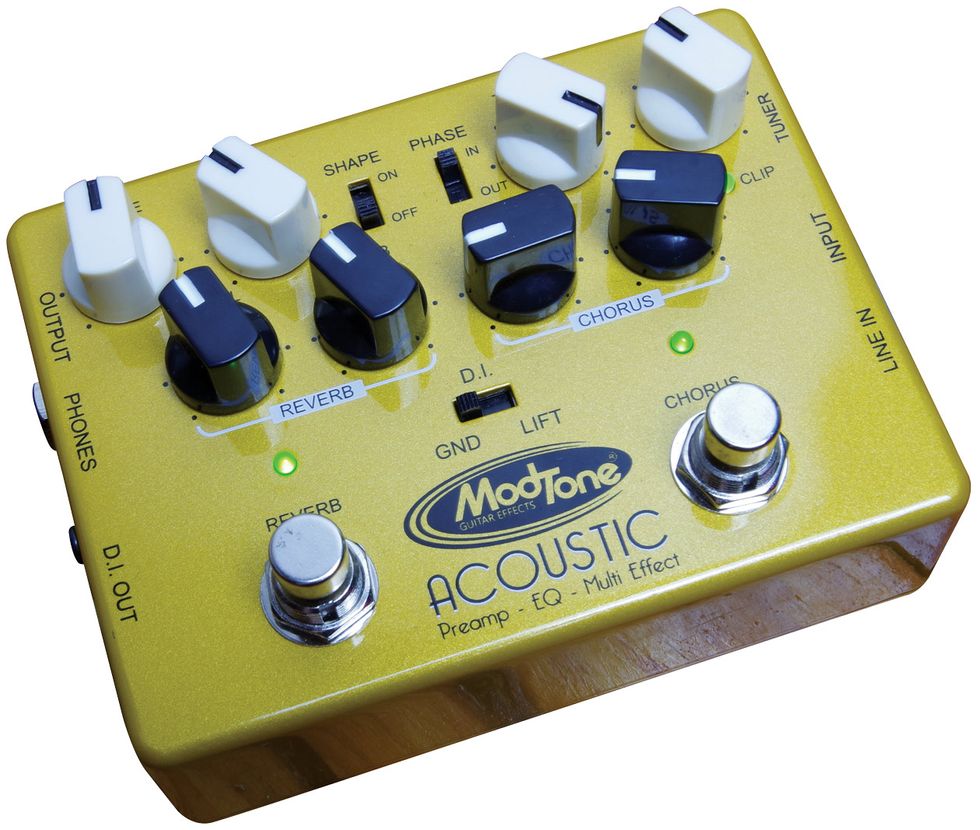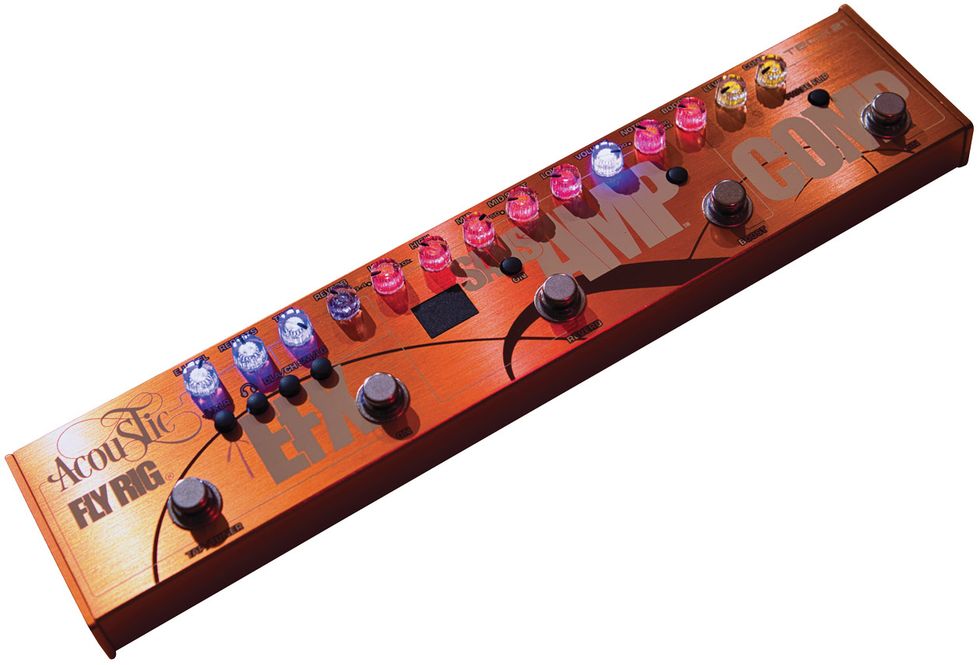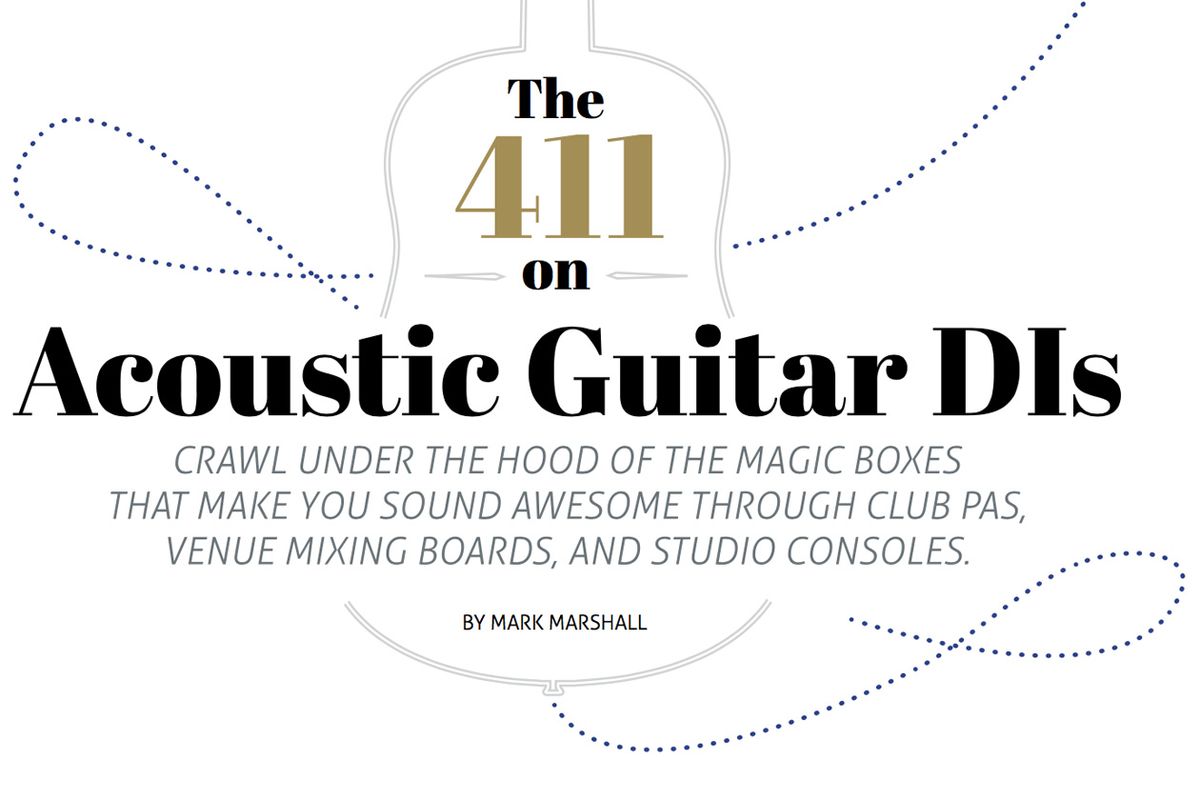
Crawl under the hood of the magic boxes that make you sound awesome through club PAs, venue mixing boards, and studio consoles.
You’ve probably heard musicians or audio engineers talk about using a DI or direct injection box onstage or in the studio. Even if you’re familiar with the term “DI,” you may be unsure about what this device actually does and when you’d want to use it. Here’s the short answer: If you play an acoustic guitar equipped with any kind of onboard pickup system, at some point you’re likely to plug it into a PA or studio console—and that’s where the DI comes in. Whether you’re gigging at a local coffeehouse, performing at a major festival, or laying down songs in the studio, it pays to be familiar with DI boxes and the host of options that are available to acoustic guitarists. So let’s get right to it.
Square One
Studio consoles and front-of-house mixing boards are designed to accept balanced, low-impedance (aka low-Z) signals from microphones. Most acoustic-electric guitars deliver an unbalanced, high-impedance (high-Z) output signal that’s appropriate for all guitar amps and pedals, but not pro audio gear. For a guitar signal to match the levels required by a mixing board, it needs to be converted. This is accomplished using a transformer, which is the beating heart of the DI.
The simplest (and least expensive) DI boxes are passive—no battery or power supply required—and provide a 1/4" input for your guitar cord and a XLR output. The latter connects to the mixer using the same type of cable as a professional mic. Boom—now you can run your guitar into the sound system.
One reason to send a high-Z guitar signal into a DI box is to ensure the guitar’s sound survives the long cable runs typically found in stage and studio setups. Here’s what’s going on: An unbalanced cable, such as a standard guitar cord, has two wires wrapped inside the outer, protective sheath. One wire carries the signal and the other is the ground. In addition to providing a critical part of the audio circuit, this ground wire can also be used to shield the signal wire from such noise as radio frequency (RF) interference and hum induced by stage lights and neon bar signs. Typically, the signal wire runs through the middle of the cable; the ground wire may be twisted around the signal wire or surround it as a braided shield. But because the cable itself can act as an antenna, this noise-reducing scheme is only effective up to about 25 feet ... at most.
Enter the balanced cable, which has three wires inside the protective sheath: two carry the signal and one is the ground. In a balanced system, the signal is carried on wires that are intentionally out of phase with each other. When these out-of-phase signals reach their destination, they’re put back in phase and that’s what we hear. At this point, any distortion or noise the signal wires have accumulated will now be out of phase with itself and thus be cancelled out. Called common mode rejection, this clever noise cancellation is what allows balanced, low-Z signals to run through cables as long as 1,000 feet with virtually no sonic degradation.
In addition to a 1/4" input and a low-Z XLR output, most DIs offer an additional 1/4" “thru” jack that lets you run your signal into a guitar amp onstage. So instead of relying on stage wedge monitors, which often sound harsh or sterile, you can listen to what you’re playing through a familiar rig—one that’s designed to flatter your flattop and give you the specialized tone-shaping and feedback-fighting controls acoustic guitarists need. Because you control your tone and volume onstage, you can bask in a familiar sound wherever you perform while simultaneously sending a low-Z signal to the sound engineer to mix with the vocal mics and other instruments.
The Radial ProDI ($100 street) is an example of a passive DI box equipped with input, output, and thru jacks. In addition to high-Z-to-low-Z signal conversion, it has a cool trick up its metallic sleeve: a switchable -15 dB pad that lowers the signal at the unit’s input—a lifesaver if your instrument’s output is so hot that it creates clipping. (This is more likely to be an issue with electronic keyboards than an acoustic-electric guitar.) The ProDI also offers a ground-lift switch that can come in handy for breaking hum-causing ground loops.
If your guitar has an onboard preamp, then a simple passive DI like Radial Engineering’s ProDI offers everything you need to connect to a studio console or venue’s mixing board: a 1/4" input and low-Z XLR output. It also has a “thru” jack to route your signal to a stage amp, which you can use as a personal monitor. This affordable workhorse has two extra goodies—a switchable -15dB pad and ground-lift switch. Photo by Mark Marshall
The Hybrid Evolution
DI boxes have been around since the dawn of pro audio, but as more acoustic guitarists began plugging into sound systems, forward-thinking manufacturers started to take a closer look at what pickers really need when performing at a venue or tracking in a home studio. If your guitar has an onboard preamp, a passive DI box may be enough to get the job done. But companies that specialize in acoustic amplification, such as Fishman and L.R. Baggs, realize that while many guitarists may have soundhole pickups or under-saddle transducers mounted in their axes, they prefer to run these through outboard gear, instead of relying on an onboard preamp that could become outdated in a few years. Why not create a hybrid device that combines a DI and an active preamp with EQ, feedback suppression circuitry, a tuner, and other tools specifically aimed at the acoustic-electric market?
Wrapping these tools into a single, convenient package makes sense because it streamlines and simplifies an acoustic guitarist’s rig. Such active DIs, which, depending on their design, get their juice from a 9V battery, an external power supply, or sometimes phantom power from a mixing console, also include many other features that passive DIs lack. Let’s discuss some of them.
The Fishman Platinum PRO EQ integrates a sophisticated analog preamp with a fully featured DI box. Its pre/post EQ switch lets you choose whether you send a straight, uncolored low-Z signal to the board or one that you’ve tweaked using the unit’s extensive onboard EQ controls. Photo by Mark Marshall
The Great Equalizer(s)
Because the guitar is a midrange-rich instrument, it makes sense that we want to adjust the frequencies in this region. But that’s not all: An active DI may have a high-pass filter (sometimes referred to as a low-cut filter) that only allows frequencies above a specified point and eliminates those below it. For example, if you set the low-cut to 120 Hz, it will remove frequencies below this threshold. How aggressive the filter is at removing those frequencies is typically preset on DI preamps.
There are a couple of good reasons to use a low-cut filter. For one, it can reduce feedback. Even though the acoustic guitar has a prominent midrange, it doesn’t mean there aren’t sub-frequencies happening. There could be a party going on down there that you’re unaware of until you plug into a PA. Rowdy low-end frequencies can cause feedback or muddy your sound. Depending on the guitar and the pickup you’re using, bloated low end can mask the rest of your tone. That’s where a high-pass filter comes in handy. Used properly, it won’t thin out your instrument’s voice, but simply unmask it.
You’ll find a variety of EQ-shaping tools on active DI devices. The flexible 5-band EQ system on the Fishman Platinum PRO EQ ($299 street) consists of six knobs: low cut, bass, a sweepable midrange with boost or cut, treble, and brilliance. Another popular active DI, the L.R. Baggs Venue DI ($299 street), has a 5-band EQ that includes bass, presence, and treble knobs, as well as tunable low-mid (100 Hz–500 Hz) and high-mid (500 Hz–2.5 kHz) controls that give you the ability to boost or cut frequencies in these regions.
For many players, a 5-band EQ with one or two sweepable midrange bands provides ample tone-sculpting power. But if you need more midrange control, some devices go further. For example, Grace Design’s ALiX ($625 street), which has its roots in high-end studio equipment, boasts fully parametric midrange controls. A parametric tone control lets you adjust the frequency, gain, and Q (the amount of surrounding frequencies that also get cut or boosted). It also has a low-pass filter (aka high-cut filter). This comes in handy if you need to put a ceiling on the upper frequency content coming from your instrument. I find this to be the case with resonator guitars, which can be piercing when plugged in, depending on your pickup system. A low-pass filter helps to control that harshness, and it’s the first adjustment I make when plugging in my National resonator.
Feedback Fighters
As anyone who has plugged in onstage can attest, feedback is the enemy of an acoustic-electric guitarist performing at a live venue. Active DI boxes offer several nifty tools for dealing with feedback.
One is a phase inversion switch. This reverses the polarity—the direction of the waveform—of your guitar signal. Flipping this switch can help reduce booming feedback by “changing its relationship to the sound coming from the amplifier,” as described in Fishman’s Platinum PRO EQ manual. The manual goes on to say, “One phase setting usually provides better resistance to feedback than the other and will vary depending on the instrument and playing environment.” So the trick is to experiment by flipping back and forth to see what position delivers better feedback reduction. A phase switch may sometimes—although not always—drastically affect your tone. So before I reach for EQ knobs, I’ll start with the phase switch. Once I find the right tonal character, I’ll move on to adjusting EQ.
Among its many features, the L.R. Baggs Venue DI offers a flexible EQ with two bands of sweepable midrange boost or cut, an adjustable gain knob with a 4-segment clipping meter, and an FX loop. Photo by Mark Marshall
Another feedback buster is the notch filter, which provides a very deep, narrow cut at a specified frequency that’s prone to feedback on most acoustic-electric guitars. Here’s how L.R. Baggs describes their Garrett Null anti-feedback notch filter, which provides a -21 dB cut at 1/8 octave, in the Venue DI manual: “Sonically it is virtually invisible and it can be used to sweep the primary feedback range of an acoustic guitar (60 Hz–320 Hz) to cut out a frequency that is causing feedback or ringing.” The trick to using a notch filter is to get your guitar to start feeding back at soundcheck. Then, as it’s howling, turn the notch filter knob until the feedback disappears.
The Grace ALiX Instrument Preamplifier squeezes the same technology as the company’s highly regarded studio preamps into an active DI box designed for a wide variety of acoustic musicians. The fully parametric midrange controls provide super-flexible EQ capability, and its three impedance switches are designed to accommodate virtually any type of pickup. The AC-powered device can also supply 9V 500 mA juice to other stompboxes. Photo by Mark Marshall
Other Cool Goodies
In addition to EQ and feedback controls, hybrid DI/preamp devices are typically loaded with features to help acoustic-electric guitarists get their music heard. Here’s what you’ll want to look for when shopping for an active DI.
Many have onboard tuners equipped with a footswitch that mutes the signal from the XLR and 1/4" outputs. Like clip-on or pedal tuners, these differ in style, but not in functionality. The Venue DI uses a circular array of LEDs to indicate whether a string is sharp, flat, or at pitch, while the Platinum PRO EQ uses a virtual needle to display this info.
Active DIs may also have a footswitchable boost that lets you set the amount of increased level you get when you stomp on it. For example, the Venue DI’s boost is adjustable up to +9 dB, and on the Platinum PRO EQ the range is from +3 to +12 dB. I use the boost for two things: The most obvious is to boost my signal for solos. But it also lets me balance the output of different pickups, when, say, I’m running two guitars through the same DI. First, I preset the levels for each guitar. Then when I switch from one to the other, all I have to do is hit the tuner/mute switch and make the swap. This spares me from having to bend over and fiddle with the preamp’s volume knob—very handy.
An active DI may have an onboard compressor. Although a few units offer separate knobs for level and compression amount, this is often a simple 1-knob affair with a fixed ratio, attack, and release—as on the Platinum PRO EQ, which also includes a multi-color LED to indicate both compression threshold and signal reduction. Even though its settings are basic, an active DI’s compressor will let you control your dynamics, and if it’s well designed, it can sound very natural.
To help you set the optimum gain for your instrument’s pickup, active DIs usually have a knob for adjusting input sensitivity (sometimes called a “trim” control), as well as some form of visual feedback if the input signal is clipping. On the Venue DI, a 4-segment LED meter indicates input level. On the Platinum PRO EQ, a single LED flashes to warn of input clipping.
When an active DI can be powered by a battery, it’s supremely helpful if the device has a battery status light. This is usually a single LED, as on the Platinum PRO EQ, although the Venue DI coverts its 4-segment LED meter into a color-coded battery status display.
These days, it’s common to find an effects loop in an active DI. It works the same way as on a guitar amp: The send routes your signal (usually after EQ and compression) to whatever effect(s) you want to include in your signal chain, and the return brings the processed sound back into the preamp. On most devices, including the Platinum PRO EQ and Venue DI, the effects loop uses 1/4" jacks for the send and return, but some, like the Grace ALiX, require inserting a tip-ring-sleeve (TRS) Y cable. Of course, you can place any stompboxes before the DI’s input, but using the effects loop is usually a quieter option.
As on a passive DI, a ground-lift switch is also a useful feature on active boxes. Ground loops can occur when there’s more than one connection to your device; lifting the ground will eliminate the hum that results from such loops.
Some active DIs, including the Platinum PRO EQ, offer a pre/post EQ switch that affects the XLR output. In the “pre” setting, the DI sends a straight, low-Z signal to the mixing board; in the “post” setting, the signal is sent to the mixer after getting EQ’d and processed, yet before it reaches the onboard master volume.
The ModTone Acoustic Preamp does double-duty as an active DI and multi-effect stomp. Its bass, treble, volume, and gain dials are augmented with four knobs to tweak chorus speed and depth, and reverb dwell and level. Unlike many active DI devices, it also offers a headphone out for those late-night practice sessions. Photo by Mark Marshall
Onboard Effects
As you investigate various active DIs, you’ll find some that include other effects, such as reverb and chorus. The ModTone Acoustic Preamp ($229 street) is one example of this approach to an all-in-one design. A simple preamp with bass, treble, volume, and gain dials, as well as phase and ground-lift switches, the ModTone also provides two footswitchable effects: reverb (with dwell and level knobs) and chorus (with speed and depth).
Tech 21’s Acoustic Fly Rig ($299 street) takes the concept of onboard effects even further. In addition to its onboard SansAmp analog preamp with 3-band semi-parametric EQ, it packs a 750 ms analog delay (with time and repeat knobs, tap-tempo footswitch, and a preset chorus option) and an independently footswitchable reverb into its slim case. All the active DI goodies are here as well: a sweepable notch filter, low-pass filter, FET-based 2-knob compressor, footswitchable boost (up to +12 dB), tuner, headphone jack, phase-reverse button, ground-lift switch, and low-Z XLR and 1/4" outputs.
In addition to being a fully featured active DI with a 3-band semi-parametric EQ, boost switch, 2-knob compressor, and tuner, Tech 21’s Acoustic Fly Rig brings a tap-tempo analog delay and footswitchable reverb to the party. The idea is to shrink a DI and basic pedalboard into a device that slips into a gig bag—or even your back pocket. Photo by Andy Ellis
Color My World
We’ve talked a lot about the features in various active DI devices, but what about their sound? I believe no device is transparent—everything you plug into colors your tone. The question is, how? And do you like it? Studio engineers spend a lot of time testing different preamps with their favorite mics. Each mic pre has its own character—an API doesn’t sound like a Neve, and a Grace doesn’t sound like a Pendulum—and the only way you get to know these subtle differences is through A/B testing.
So it goes in the world of acoustic DI preamps. What sounds best is subjective, and you have to discover this for yourself. Bring your favorite acoustic-electric to your local music store, sequester yourself in their listening room, and get busy trying out some of the devices we’ve described here, as well as any other units you can get your mitts on. And—just like with any distortion or delay pedal—the user interface can impact your buying decision, so be sure to test as many DIs as you can. Using the info we’ve covered here, you’ll soon be ready to take the stage with your favorite acoustic DI.
- Flattop Curve Appeal - Premier Guitar | The best guitar and bass reviews, videos, and interviews on the web. ›
- Recording Dojo: Why Guitarists Shouldn't Diss DIs - Premier Guitar ›
- Guitar Shop 101: How to Install a Soundhole Pickup - Premier Guitar ›
- Why John Bohlinger Likes Playing Acoustic Guitar - Premier Guitar ›
- Vintage Kay Carson Robinson Guitar and Louise Massey - Premier Guitar ›
- Vintage Kay Carson Robinson Guitar and Louise Massey - Premier Guitar ›
- The Magic of Contact Mics for Acoustic Guitars - Premier Guitar ›
- Taylor 417e Review - Premier Guitar ›
- Guild D-50 Standard Acoustic Guitar Review ›
- A Lawsuit-Era Takamine F-4450S-A to Contend with Martin ›
